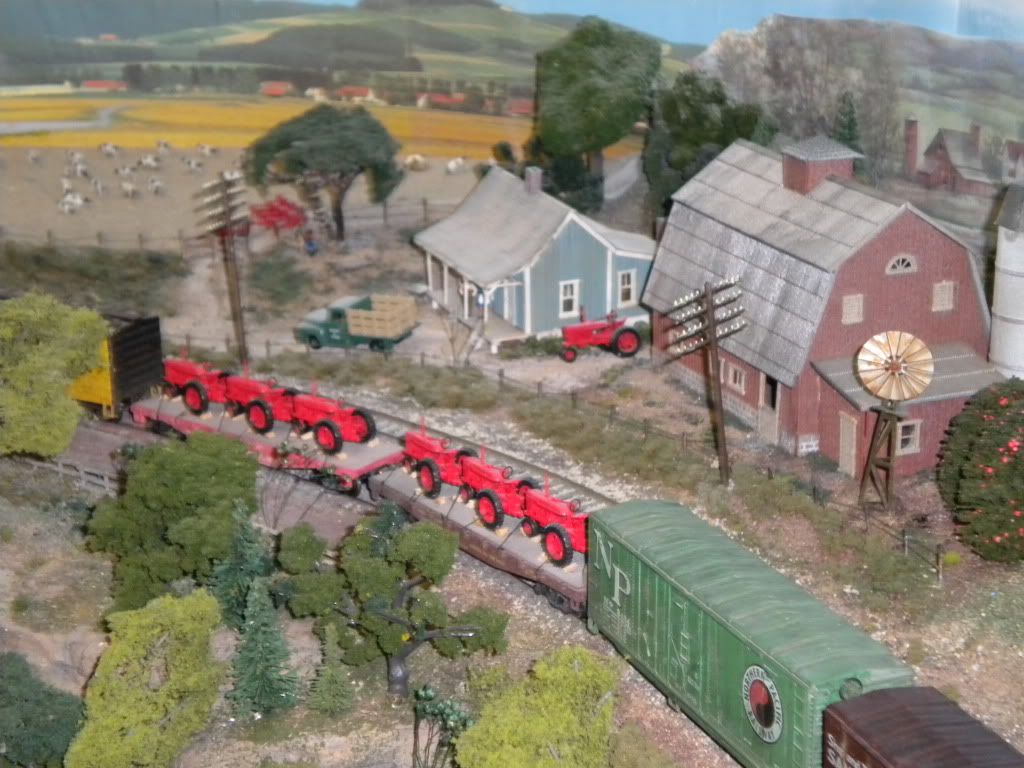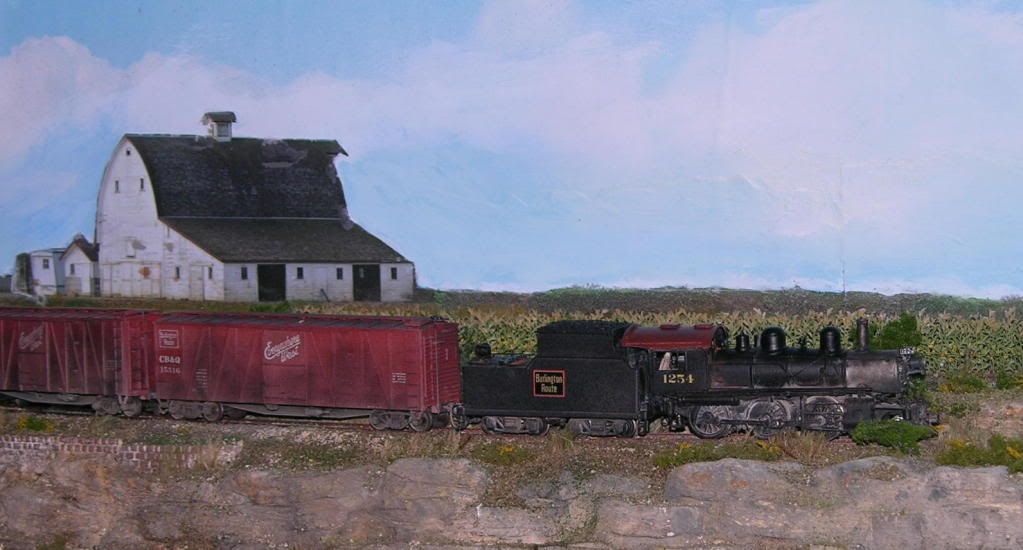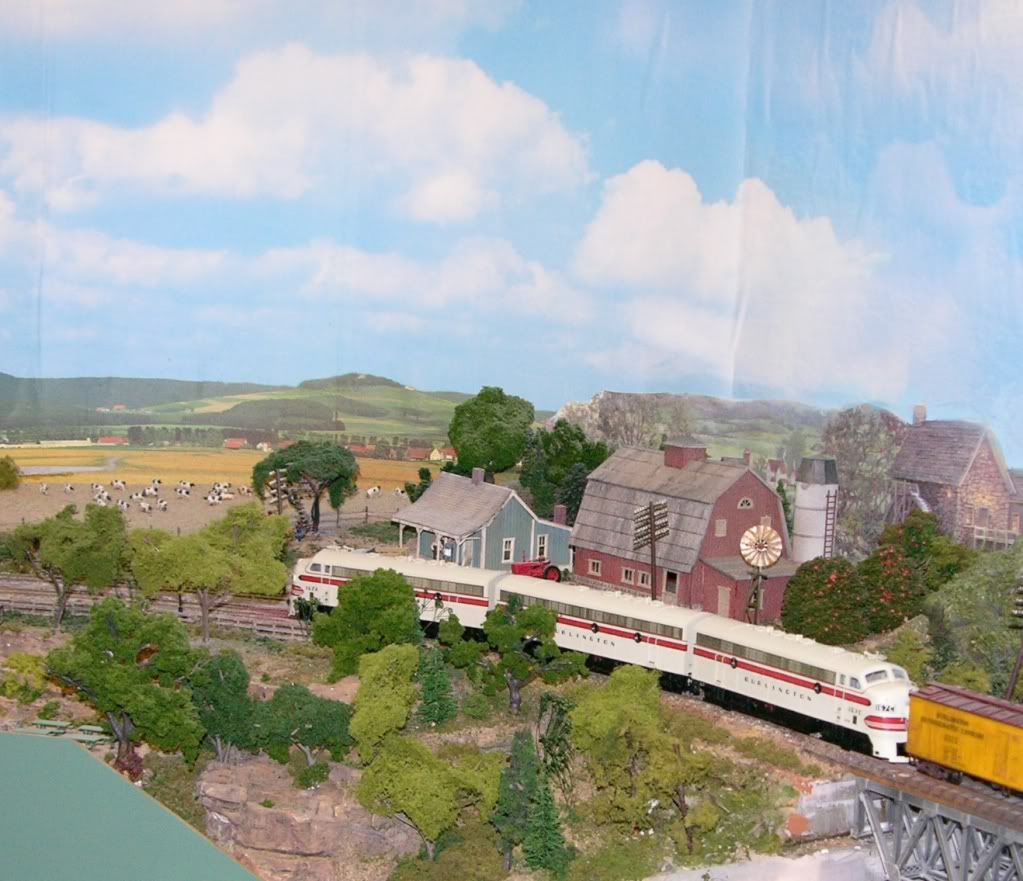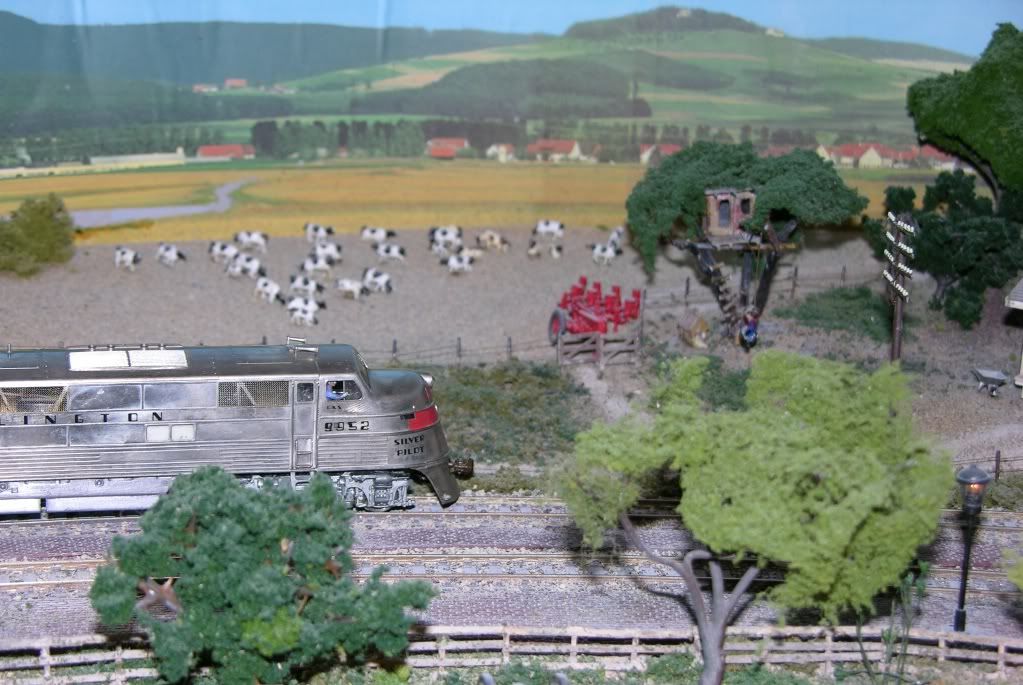In certain regions, you can use modern aerial imagery on Bing and Google to study old farms. My grandparents have aerial photos of their farm from the late 50s, mid 80s, and late 90s hanging in the house and almost nothing has changed in them except the trucks. Tractors are the same even. My old stomping grounds of Western PA are practically the same in my entire memory.
NittanyLion is right about the milkhouse, sometimes it was an attached room, other places a seperate building, usually fairly close to the barn. Sometimes they weren’t too close if they had lost a barn to fire or just built a new barn. However, in the era you are modeling they used milk cans, not the big tank that the shiney truck came every other day to pick up milk from. They came in in the early 50’s and put a lot of small farms out of bussiness, they couldn’t afford them. My uncle and his neighbor shared taking the cans to the creamery in their pick ups. Can’t remember if the cans went daily or every other day. They were kept in a waterbath cooler in the milkhouse. I do remember that a full 40 quart can, milk and can, totaled 100 pounds. When visiting the farm as a kid, I reloaded the truck with empties, felt pretty big when I could slide the full cans out of the truck onto the rollers. Think they were gone before I could haul them out of the cooler and onto the truck.
Have fun,
Richard
Frank,
Everyone has provided good info and advice. I wanted to share some pictures I took at last years Amherst Model Railroad show. I don’t know who the owner of the layout module is but I thought that they did a great job capturing the feel of a small dairy farm and thought that it might give you some ideas. Hope they can give you some inspiration. Enjoy.
!(http://i155.photobucket.com/albums/s292/Pmoughty/Model Railroad/IMG_0008.jpg)
!(http://i155.photobucket.com/albums/s292/Pmoughty/Model Railroad/IMG_0009.jpg)
!(http://i155.photobucket.com/albums/s292/Pmoughty/Model Railroad/IMG_0010.jpg)
Pat
I like the farm scenes posted here. They should provide many good ideas.
I have a farm located betwen the track and the backdrop in one corner.

Also, I use backdrops with farm scenes and only have a narrow portion of the layout with farm scenery on the surface.

Great pictures, don’t forget the water source, livestock consume a lot of water. A pond, creek or a windmill & water tank all make interesting modelling scenes, hedgerows, overgrown fences, etc. As usual, the skys the limit.
Hello
Motley thanks for the link but I am not sure if I want a kit I may try and scratch build what I need first.
Leighant that is a great site some one gave me the link a couple years ago but I forgot about it.
Rich that is a nice farm it looks like a new farm a little to new and big for my space and time.
Heartland division I really like the backdrop with the cows where did you get it? It would make my space look big for sure.
The space I have is 2’ x 1’5’’ It sets between a road and a two track main. So I will have to cross the tracks to get to the pastures. Witch would be the backdrop. Here is a shot.

I do like the idea of using milk cans. And the three sided shed for the tractor. Would the windmill pump the water to where it was needed or was that done by hand and bucket ? What else could be used for a chicken coup? Would the water troffs be wood or metal? Thanks everyone for you photos and help Frank
0-6-0 … Thanks for the remark. The cows actually are not in the back drop. They are N scale cows on my HO layout on a surface that slopes upward from tracks to backdrop.
The backdrop behind the cow pasture is by Faller. Behind the barn is a piece of wallpaper I found and used for a backdrop. The backdrop curves because it is the back corner of the layout.
There are numerous farm detail items available such as Woodland Scenics Treehouse which is in my farm.
Here are two more views.


Good point, especially around where I grew up. One thing to keep in mind is the classic “barn” wasn’t common across the US. Most barns in the south were much smaller and more shed looking. As an example, a friends dairy in the 60s had a concrete block milk house. Next to it was a hay shed – basically a pole frame galvanized roofing and no sides, bales just stacked under it. Between the hay shed and milk house was a feed lot where the cows were turned after milking. Across from the milk house was a three sided trackter shed. The house was one of the smaller buildings (dwarfed by the hay shed) about 75 yards away.
One interesting note to model – when it got toward milking time, the cows knew to head toward the milkhouse. You would have a very interesting “train” of cows lining up to be first to get milked (and there was a pecking order). Depending on how bunched and close to the milk house would mean it’s about 4-5 pm.
That type of windmill would be for pumping water from the ground. Not many of them around here, though I remember one. It probably pumped water into a large holding tank somewhere. It could be elevated (up in the barn) to provide pressure for distribution or if it were at ground level a water pump could have provided the pressure. Some hand distribution to smaller needs livestock pens would have been normal. The troughts could be made from either metal or wood.
Most anything can serve as a chicken coop. Friend of mine had one with a 4’x8’ sheet of plywood (soumd familiar) for the floor, high enough to walk in, ducking. My grandsons is about 3’x3’ on legs, homemade, with a fenced yard, nothing fancy. Often an small shed looking thing would be thrown together. Just need to be able to secure it at night from egg thieves and predators and be able to get to the nests to get the eggs out.
Have fun,
Richard
Hello I have been working on few things. I got my three sided tractor shed done. And built a windmill but not sure if I like the fan wheel. Anyone have any ideas on what I can use to make a fan wheel from?




The shed is made from scrap wood and metal siding for the roof. Have a nice day Frank
Frank
The traditional gambrel roofed barn we think of today did not become popular until after WW2. Before that smaller gable ended shed type barns or rounded roof barns were used as well as circular round barns. In areas of heavy snowfall connected barns were popular especially out east so you did not have to go outside in 3 feet of snow. For a dairy farm you need a silo for silage a ground up corn and greens mixture that was fermented. A dairy farm needs a bull for breeding and would be in a separate pen and shed type barn away from the females. Also in the time you model black and white were not very common. People preferred milk with higher milk fat percentages like from a Guernsey or a .
Bill
Ah, smell that dairy air!
John
In the October 1966 edition of Model Railroader, the column “MR Clinic” is devoted to modeling farms. There are a few small, but interesting photos, and a drawing showing a typical farm layout.
Hello well I been working on the farm when I have time and this what I got done so far. I rebuilt the fan wheel on the wind mill and added a 1500gal water tank. And a pig pen.





I made the blade from tin foil and the pig pen is made of bits from the junk box. The dirt is real and I mixed some with polyurethane to make the mud. I still have more to do. Let me know what you think. Have a nice day Frank
Like the general layout of your farm. Quite neat, but I know there are farms that have the time and help to keep them really nice looking. Only thing I might add is more dirt where vehicles move around a lot.
Actually the first thing to hit me was the size of the windmill inthe first photo. Any water pumping windmills I have seen have had a fairly small diameter wheel and a narrower base. I don’t remember seeing any such things when I was in Ohio, so yours may be typical of your location. For the windmills I have seen I would cut the fins shorter. Also, I think oolder windmills had wooden fins, but some could have had metal.
Good work,
Richard
Frank, The most important thing about farm layout is the prevailing winds. You want the house upwind from any animal housing structures such as feed lots, hog barns or chicken coops and turkwy barns. Beyound that, remember that feeding animals is very important and prior to 1960 was usually done by hand or with small carts at best. Keep the silos, haybarns and corn cribs accessable. You also need some lanes to get to the fields. beyond that look at pictures of farms of the era you model to give you direction.
Thom
Hi! Our Farm and most dairy farms had a milk house. A small building made of stone or block to keep the milk cold until pickup time. Ours was block, built on an artisian spring to add a chill to the milk. Also they had a platform outside for loading into a train car, truck or onto a wagon. If the farm was by the tracks a “milk run” would pick the milk cans up on it’s run. If not the cans where put out when the pick up was made, next to the road.
Around our farming dairy country here, the farms are laid out thusly:
The {big} farmhouse is usually upwind form the barn and on one side of the road or driveway. The barn is on the other side of teh road or driveway close to the road. That is so the Semi milk trucks can get in and out easily to get the milk to take to market. The barn itself usually has the milking bays in the basement or lower level with a big huge “first story” or “attic” that is designed to hold hay. Lots of it. Lots of hay. SOmetimes there is even a second floor or attic to the first floor where rectangle bales are sent up conveyors to the storage area there. The barn needs to be close to the road for the trucks, and needs to be close enough to the house to walk to. Silos and corn cribs may or may not be present, and may be separate from the barn or attached. Fields around and close to the barn are usually left to be fallow or planted with some nutritious elements for the cows to graze on in the summer {like clover}. Fields further away are used for haying and corn crops or other market produce.
There may be another barn for storage of the farming implements or they are stored up in the first floor while hay is stored on the second floor.
lately they have changed to rolled bales of hay, sealed in heavy white plastic for winter storage in teh fields near and far. They look like big marshmallows. They are collected and delivered to the cows via a pole sticking out of a tractor attachment.
Manuer {sp?}is shoveled out of the barns via tractor to an area behind the barn, usually in a cement foundation with no roof where it is piled and covered with plastic until it is needed to be spread in the spring. {they have found at Cornell University’s Agricultural cetner that spreading it over snow in winter in the fields simply means it washes off when the spring rains come and doesn’t get to sink in the ground to do the fertilizing it should…so now they wait to spread it later}. SOme of these manuer piles
I live on a farm (it was a dairy farm, but now we are farming just crops).You can do anything but it depends on where it is in the world.
But there is one thing that should be on it a tractor(green are the best). =:)
did a little research when i built farm on my layout . Farm can just be lay-ed out anyway . Here is a photo of it and you can see it is set up in away that look like a farm hope this help es .By the way the farm is set 2010 and in south west new Mexico.

